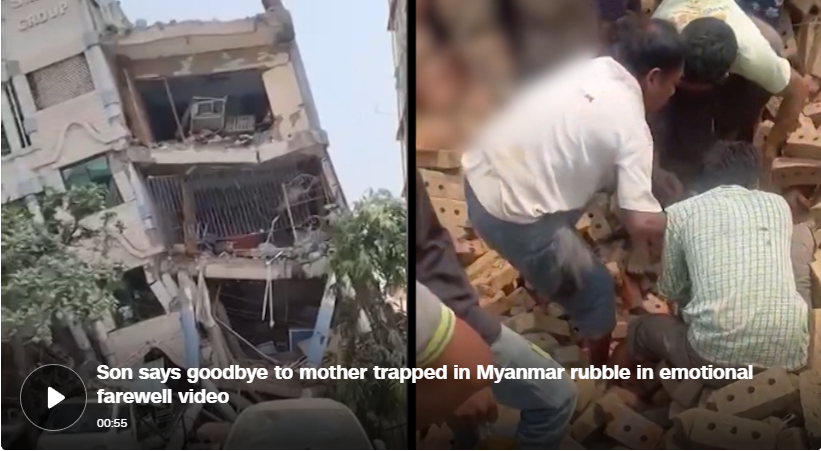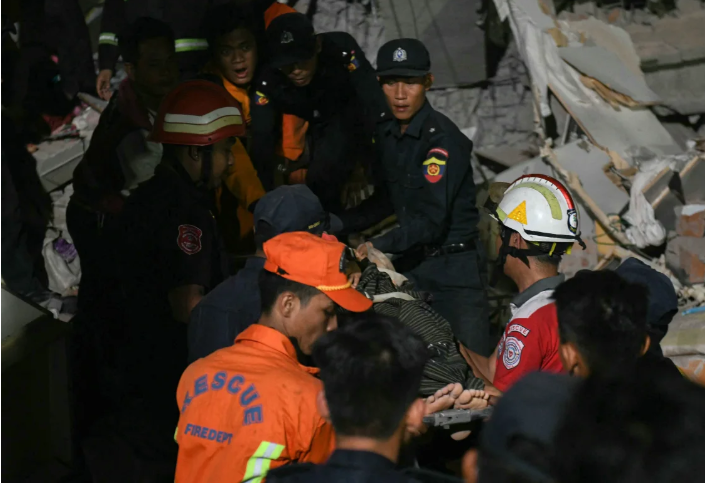
Rescuers are desperately searching for survivors more than three days after a powerful 7.7-magnitude earthquake struck Myanmar, toppling buildings as far away as the Thai capital Bangkok and sending tremors through nearby Chinese provinces.
The first 72-hours after a quake are widely regarded as the “golden” window to reach victims buried alive under rubble – after that period the chances of survival without a water source diminishes rapidly.
At least 1,700 people are now confirmed dead in Myanmar after what was the largest earthquake to hit the war-ravaged country in more than a century, authorities say. Experts fear the true death toll could take weeks to emerge.

Widespread damage has been reported after the quake caused bridges and buildings to collapse, including in Bangkok, where authorities are trying to free dozens believed to be trapped under the rubble of an under-construction high-rise.
The epicenter was recorded in Myanmar’s central Sagaing region, near the former royal capital Mandalay, home to around 1.5 million people, as well as multiple historic temple complexes and palaces. Those at the epicenter of the quake are largely cut off following the collapse of a key bridge over the country’s Irrawaddy River, according to local officials.
Meanwhile, foreign aid and international rescue teams have started arriving in Myanmar after the military junta issued a rare plea for help.
Friday’s quake was the deadliest natural disaster to hit the country in years and comes as Myanmar reels from a civil war that since 2021 has damaged communication networks, battered health infrastructure and left millions without adequate food and shelter.
Here’s what we know.

Massive human toll
At least 1,700 people are dead and around 3,400 injured, according to the country’s military government. Nearly 300 others remain missing.
The United States Geological Survey (USGS) estimated that the final death toll could surpass 10,000 people, based on early modeling.
In Bangkok, hundreds of miles from the epicenter, at least 18 people were killed. Of these, 11 died when an under-construction building collapsed in minutes, leaving dozens trapped under the rubble. Seven fatalities were reported elsewhere in the capital, authorities said.
Search and rescue operations are ongoing in Bangkok for around 80 people who remain missing, as families gather at the site of the collapsed high-rise for any news of their loved ones.
“I’ve called my husband who’s trapped inside countless times. Probably 100 to 200 calls a day, but none of them go through,” Kannika Noommisri told Reuters.
The earthquake was the most powerful to strike Myanmar since it was rocked by a 7.9-magnitude temblor in 1912 in Taunggyi, a city also in central Myanmar.
Aftershocks, the largest of which was a 6.7-magnitude tremor Friday, have continued throughout the weekend, according to the USGS.

Widespread devastation
The level of devastation wreaked on the country “hasn’t been seen in over a century in Asia,” according to an official from the International Federation of Red Cross and Red Crescent Societies (IFRC).
Speaking to CNN from Yangon, Marie Manrique, IFRC’s Myanmar program coordinator, said that there was now just a “small window of opportunity” left to reach those people trapped under the rubble.
One woman in Mandalay recalled: “It hit very strong and very fast.” Part of a wall collapsed onto the woman’s grandmother who was sitting nearby, burying her legs in rubble and debris, she said.
A former lawyer in the city also told CNN that three members of his wife’s family had been killed in the quake.
The quake also shattered some of the city’s mosques, which were busy with worshippers attending Friday prayers, one man said.
Since the quake struck, communication has been difficult with people in Myanmar, including Mandalay – making it hard to assess the true extent of the damage.
Save the Children, an NGO providing aid in affected areas, relayed the testimony of a father in the badly hit eastern Shan state.
“Children and the elderly experienced severe dizziness and fainting… The earthquake was incredibly strong, and we were all in shock. Young children cried and screamed in fear ,” he said, adding that there was now an urgent need for food and water.